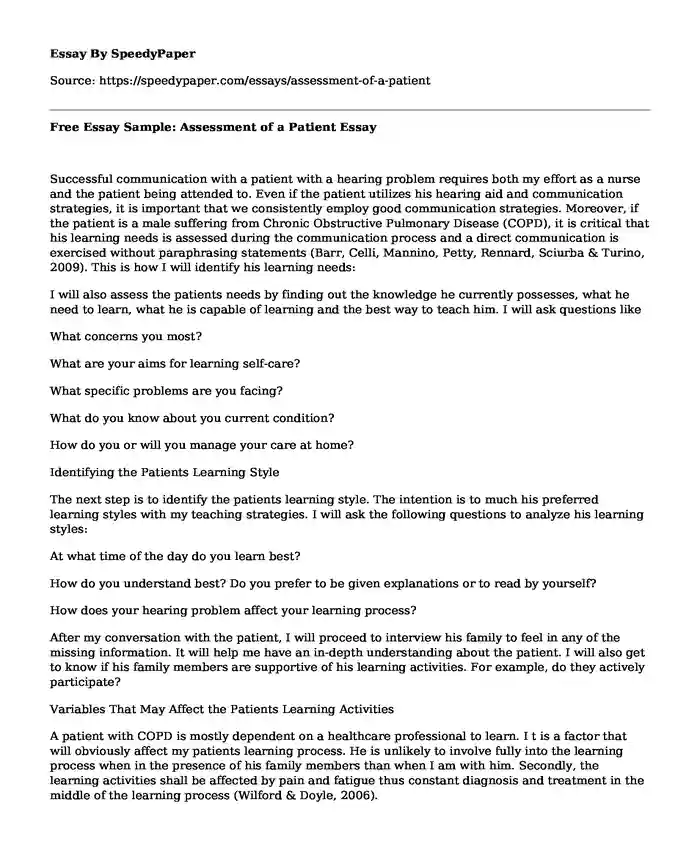
| Type of paper: | Essay |
| Categories: | Health and Social Care Medicine |
| Pages: | 3 |
| Wordcount: | 702 words |
Successful communication with a patient with a hearing problem requires both my effort as a nurse and the patient being attended to. Even if the patient utilizes his hearing aid and communication strategies, it is important that we consistently employ good communication strategies. Moreover, if the patient is a male suffering from Chronic Obstructive Pulmonary Disease (COPD), it is critical that his learning needs is assessed during the communication process and a direct communication is exercised without paraphrasing statements (Barr, Celli, Mannino, Petty, Rennard, Sciurba & Turino, 2009). This is how I will identify his learning needs:
I will also assess the patients needs by finding out the knowledge he currently possesses, what he need to learn, what he is capable of learning and the best way to teach him. I will ask questions like
What concerns you most?
What are your aims for learning self-care?
What specific problems are you facing?
What do you know about you current condition?
How do you or will you manage your care at home?
Identifying the Patients Learning Style
The next step is to identify the patients learning style. The intention is to much his preferred learning styles with my teaching strategies. I will ask the following questions to analyze his learning styles:
At what time of the day do you learn best?
How do you understand best? Do you prefer to be given explanations or to read by yourself?
How does your hearing problem affect your learning process?
After my conversation with the patient, I will proceed to interview his family to feel in any of the missing information. It will help me have an in-depth understanding about the patient. I will also get to know if his family members are supportive of his learning activities. For example, do they actively participate?
Variables That May Affect the Patients Learning Activities
A patient with COPD is mostly dependent on a healthcare professional to learn. I t is a factor that will obviously affect my patients learning process. He is unlikely to involve fully into the learning process when in the presence of his family members than when I am with him. Secondly, the learning activities shall be affected by pain and fatigue thus constant diagnosis and treatment in the middle of the learning process (Wilford & Doyle, 2006).
Learning Objective
The objective of the patient learning process is characterized with cognitive, affective and psychomotor domain in relation to the patient and COPD.
Cognitive Objective
Define COPD
Explain COPD
Identify the signs and symptoms of COPD.
Describe the impact of COPD on the patient and his family.
Interpreted the emerging signs of COPD
Understand the effectiveness intervention and rehabilitation methods of COPD
Demonstrate how to control cough and other relaxation techniques
Plan his rehabilitation process
Evaluate his health progress
Affective Domain
Help the patient understand the learning process in a much efficient manner.
Employ sensitivity in the learning process
Create clear rehabilitation plan that a patient can practice.
Share with the patient the knowledge about COPD
Psychomotor Domain
Help the patient evaluate and detect any physical change before and after medication.
Practice all the rehabilitation skills as required.
Combine the knowledge about COPD to manage himself.
Instruction Methods
I will focus on the diagnostic tests of the patient. In this case, the patient has functional disability that is partial hearing and severe respiratory symptoms. I will encourage direct communication with the patient without paraphrasing statements. I will also take the patient through the necessary knowledge for COPD. Moreover, I will carry out a breathing test of the patient by instructing him to blow hard inside a tube. It is a process called spirometry. After the diagnosis, I will teach him the COPD rehabilitation processes that suit him. Finally, I will keep my instructions as brief as possible while repeating exact words without paraphrasing (Wilford & Doyle, 2006).
References
Barr, R. G., Celli, B. R., Mannino, D. M., Petty, T., Rennard, S. I., Sciurba, F. C., ... & Turino, G. M. (2009). Comorbidities, patient knowledge, and disease management in a national sample of patients with COPD. The American journal of medicine, 122(4), 348-355.
Wilford, A., & Doyle, T. J. (2006). Integrating simulation training into the nursing curriculum. British Journal of Nursing, 15(17), 926-931.
Cite this page
Free Essay Sample: Assessment of a Patient. (2019, Nov 18). Retrieved from https://speedypaper.net/essays/assessment-of-a-patient
Request Removal
If you are the original author of this essay and no longer wish to have it published on the SpeedyPaper website, please click below to request its removal:
- Essay Example on Women Exercising While Pregnant
- Racial Discrimination Essay Example for Your Free Use
- Gregor's Relationship with the Chief Clerk, HRM Essay Example
- Free Essay: Procurement Processes of Land Mark Computers and Risks to the Business
- Free Essay Example on the American Dream
- Free Essay Comparing President Obama and Trump's Immigration Policy
- Free Essay on Importance and Implications of Health and Fitness
Popular categories




